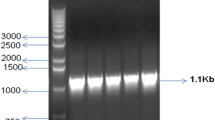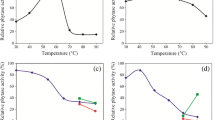Abstract
A novel phytase producing thermophilic strain of Bacillus laevolacticus insensitive to inorganic phosphate was isolated from the rhizosphere soil of leguminous plant methi (Medicago falacata). The culture conditions for production of phytase by B. laevolacticus under shake flask culture were optimized to obtain high levels of phytase (2.957 ± 0.002 U/ml). The partially purified phytase from B. laevolacticus strain was optimally active at 70 °C and between pH 7.0 and pH 8.0. The enzyme exhibited thermostability with ∼80% activity at 70 °C and pH 8.0 for up to 3 h in the presence/absence of 5 mM CaCl2. The phytase from B. laevolacticus showed high specificity for phytate salts of Ca+ > Na+. The enzyme showed an apparent K m 0.526 mM and V max 12.3 μmole/min/mg of activity against sodium phytate.









Similar content being viewed by others
References
Angelis MD, Gallo G, Carbo MR, McSweeney LH, Faccia M, Gobbetti M (2003) Phytase activity in sourdough lactic acid bacteria: purification and characterization of phytase from Lactobacillus sanfranciscensis CB1. Int J Food Microbiol 87(3):259–270
Bradford MM (1976) A rapid and sensitive method for the quantification of microgram quantities of protein utilizing the principle of protein-dye binding. Anal Biochem 72:248–254
Chadha BS, Gulati H, Minhas M, Saini HS, Singh N (2004) Phytase production by the thermophilic fungus Rhizomucor pusillus. World J Microb Biotechnol 20:105–109
Chelius MK, Wodzinski RJ (1994) Strain improvement of Aspergillus niger for phytase production. Appl Microb Biotechnol 4:79–83
Chen JC (1998) Novel screening method for extracellular phytase-producing microorganisms. Biotechnol Tech 12 (10):759–761
Cheryan M (1980) Phytic acid interactions in food systems. CRC Crit Rev Food Sci Nutr 13:297–335
Cho JS, Lee CW, Kang SH, Lee JC, Bok JD, Moon YS, Lee HG, Kim SC, Choi YJ (2003) Purification and characterization of a phytase from Pseudomonas MOK1. Curr Microbiol 47:290–294
Cho J, Lee C, Kang S, Lee J, Lee H, Bok J, Woo J, Moon Y, Choi Y (2005) Molecular cloning of a phytase gene (PhyM) from Pseudomonas syringae MOK1. Curr Microbiol 51:11–15
Choi YM, Suh HJ, Kim JM (2001) Purification and properties of extracellular phytase from Bacillus sp. KHU-10. J Protein Chem 20:287–292
Ebune A, Al-Asheh S, Duvnjak Z (1995) Effect of phosphate, surfactant and glucose on phytase production and hydrolysis of phytic acid in canola meal by Aspergillus ficuum during solid state fermentation. Bioresour Technol 54:241–247
Fredrikson M, Andlid T, Haikara A, Sandberg AS (2002) Phytate degradation by microorganisms in synthetic media and pea flour. J Appl Microbiol 93:197–204
Greiner R, Haller E, Konietzny U, Jany KD (1997) Purification and characterization of phytase from Klebsiella terrigena. Arch Biochem Biophys 34:201–206
Greiner R, Konietzny U, Jany D (1993) Purification and characterization of two phytases from Escherichia coli. Arch Biochem Biophys 303:107–113
Haefner S, Knietsch A, Scholten E, Braun J, Lohscheidt M, Zelder O (2005) Biotechnology production and applications of phytases. Appl Microbiol Biotechnol 68:588–597
Harland BF, Morris ER (1983) Phytate: a good or a bad food component. Nutr Res 15:733–754
Howson SG, Davis RP (1983) Production of phytate hydrolyzing enzyme by some fungi. Enzyme Microb Technol 5:377–382
Idriss EE, Makarewicz O, Farouk A, Rosner K, Greiner R, Bochow H, Richter T, Borriss R (2002) Extracellular phytase activity of Bacillus amyloliquefaciens FZB45 contributes to its plant-growth-promoting effect. Microbiology 148:2097–2109
Jareonkitmongkol S, Ohya M, Watanabe R, Takagi H, Nakamori S (1997) Partial purification from a soil isolates bacterium, Klebsiella oxytoca MO-3. J Ferment Bioeng 83:393–394
Jiang G, Krishnan AH, Kim YW, Wacek TJ, Krishnan HB (2001) A functional myo-inositol dehydrogenase gene is required for efficient nitrogen fixation and competitiveness of Sinorhizobium fredii USDA191 to nodulate soybean (Glycine max [L.] Merr.). J Bacteriol 183:2595–2604
Kerovuo J, Lauraeus M, Nurminen P, Kalkkinen N, Apajalahti J (1998) Isolation characterization molecular gene cloning and sequencing of a novel phytase from Bacillus subtilis. Appl Environ Microbiol 64:2079–2085
Kerovuo J, Rouvinen J, Hatzack F (2000) The metal ion dependence of Bacillus subtilis phytase. Biochem Biophys Res Commun 268:365–369
Kim YO, Kim HK, Bae KS, Yu JH, Oh TK (1998) Purification and properties of thermostable phytase from Bacillus sp. DSII. Enzyme Microb Technol 22:2–7
Lambrechts C, Boze H, Moulin G, Galzy P (1992) Utilization of phytate by some yeasts. Biotechnol Lett 14:61–66
Lan GQ, Abdullah N, Jalaludin S, Ho YW (2002) Culture conditions influencing phytase production of Mitsuokella jalaludinii, a new bacteria species from the rumen of cattle. Appl Microbiol 93:668–674
Maenz DD, Engele-schaan CM, Newkirk RW, Classen HL (1999) The effect of minerals and mineral chelators on the formation of phytase-resistant and phytase-susceptible forms of phytic acid in solution and in a slurry of canola meal. Anim Feed Sci Technol 81:177–192
Mitchell DB, Vogel K, Weimann BJ, Pasamontes L, Van Loon APGM (1997) The phytase subfamily of histidine acid phosphatase: isolation of genes for two novel phytases from the fungi Aspergillus terreus and Myceliophthora thermophila. Microbiology 143:245–252
Oh BC, Choi WC, Park S, Kim YO, Oh TK (2004) Biochemical properties and substrate specificity of alkaline and histidine acid phytases. Appl Microbiol Biotechnol 63:362–372
Power VK, Jagannathan V (1982) Purification and properties of phytate-specific phosphatase from Bacillus subtilis. J Bacteriol 151:1102–1108
Richardson AE, Hadobas PA (1997) Soil isolates of Pseudomonas spp. that utilize Inositol phosphates. Can J Microbiol 43:509–516
Sarvas M (1995) Gene expression in recombinant Bacillus. In: Smith A (eds) Gene expression in recombinant microorganism. Marcel Dekker Inc., NY
Shieh TR, Ware JH (1968) Survey of microorganisms for the production of extracellular phytase. Appl Microbiol 16:1348–1351
Shimizu M (1992) Purification and characterization of phytase from Bacillus subtilis (natto) N—77. Biosci Biotechnol Biochem 56:1266–1269
Simon O, Igbasan F (2002) In vitro properties of phytase from various microbial origins. Int J Food Sci Technol 37:813–822
Sreeramulu G, Srinivasa DS, Nand K, Joseph R (1996) Lactobacillus amylovorus as a phytase producer in submerged culture. Lett Appl Microbiol 23:385–388
Sunitha K, Lee JK, Oh TK (1999) Optimization of medium components for phytase production by E. coli using response surface methodology. Bioprocess Eng 21:477–481
Wang X, Upatham S, Panbangred W, Isarangkul D, Summpunn P, Wiyakrutta, Meevootisom V (2004) Purifictaion, characterization, gene cloning and sequence analysis of a phytase from Klebsiella pnuemoniae subsp. Pneumoniae XY-5. Sci Asia 30:383–390
Yoon SJ, Choi Y J, Min HK, Cho KK, Kim JW, Lee SC, Jung YH (1996) Isolation and identification of phytase producing bacterium. Enterobacter sp. 4, and enzymatic properties of phytase enzyme. Enzyme Microb Technol 18:449–454
Acknowledgment
The financial support by CSIR to BSC is duly acknowledged.
Author information
Authors and Affiliations
Corresponding author
Rights and permissions
About this article
Cite this article
Gulati, H.K., Chadha, B.S. & Saini, H.S. Production and characterization of thermostable alkaline phytase from Bacillus laevolacticus isolated from rhizosphere soil. J Ind Microbiol Biotechnol 34, 91–98 (2007). https://doi.org/10.1007/s10295-006-0171-7
Received:
Accepted:
Published:
Issue Date:
DOI: https://doi.org/10.1007/s10295-006-0171-7




